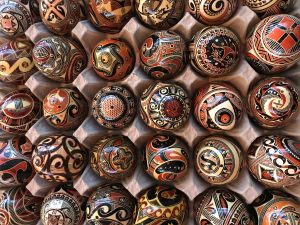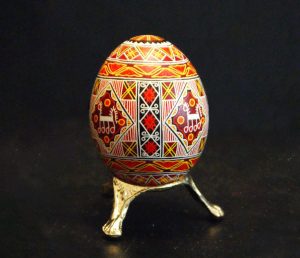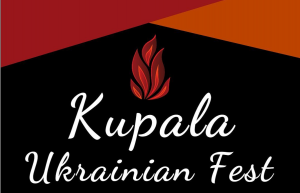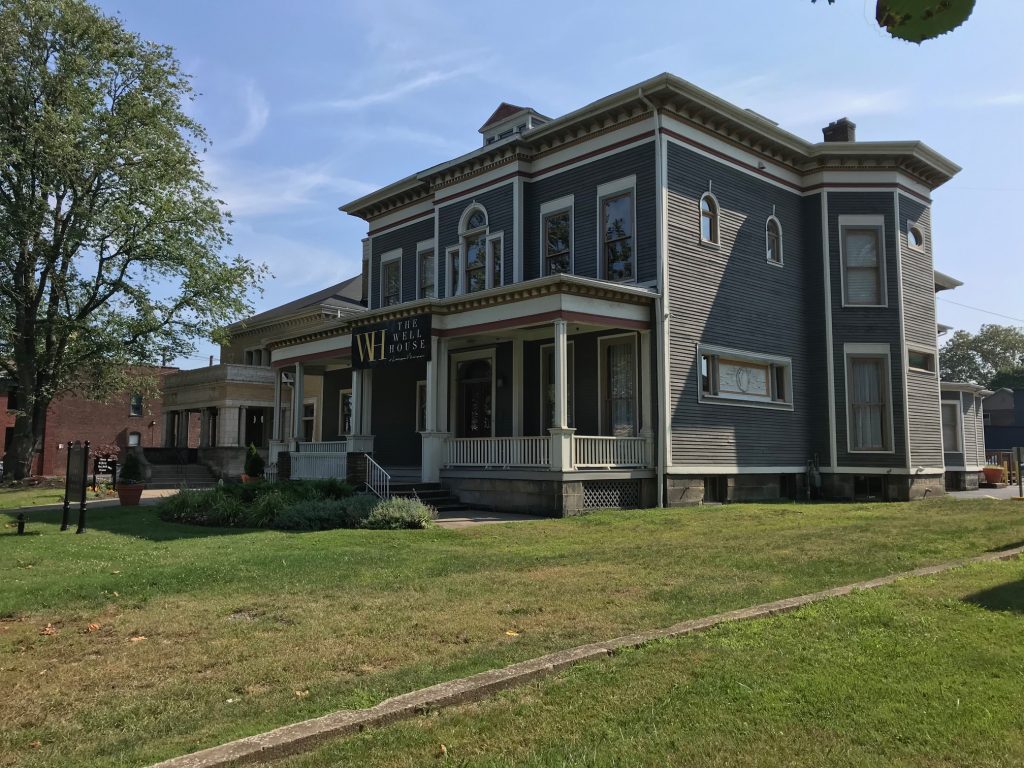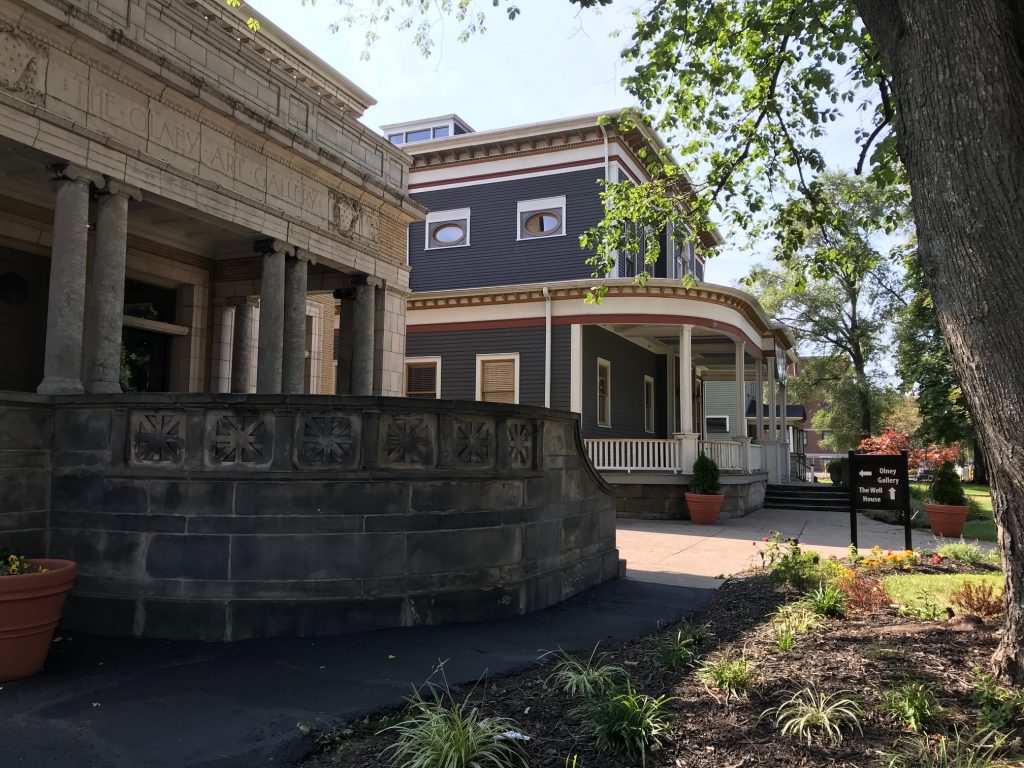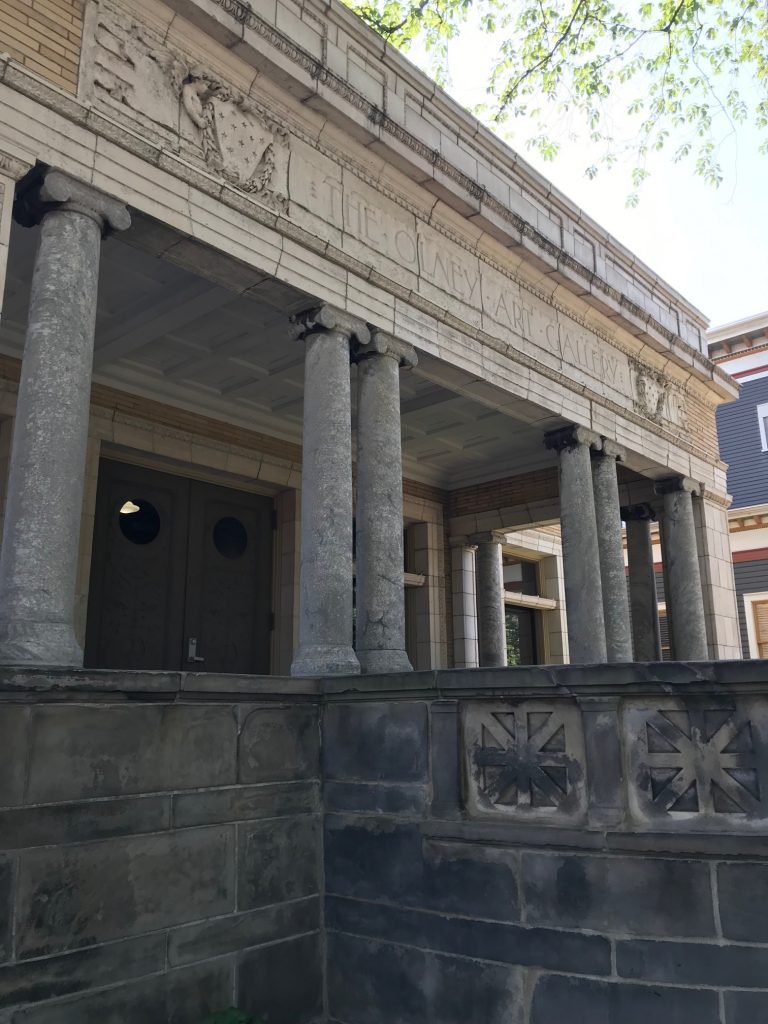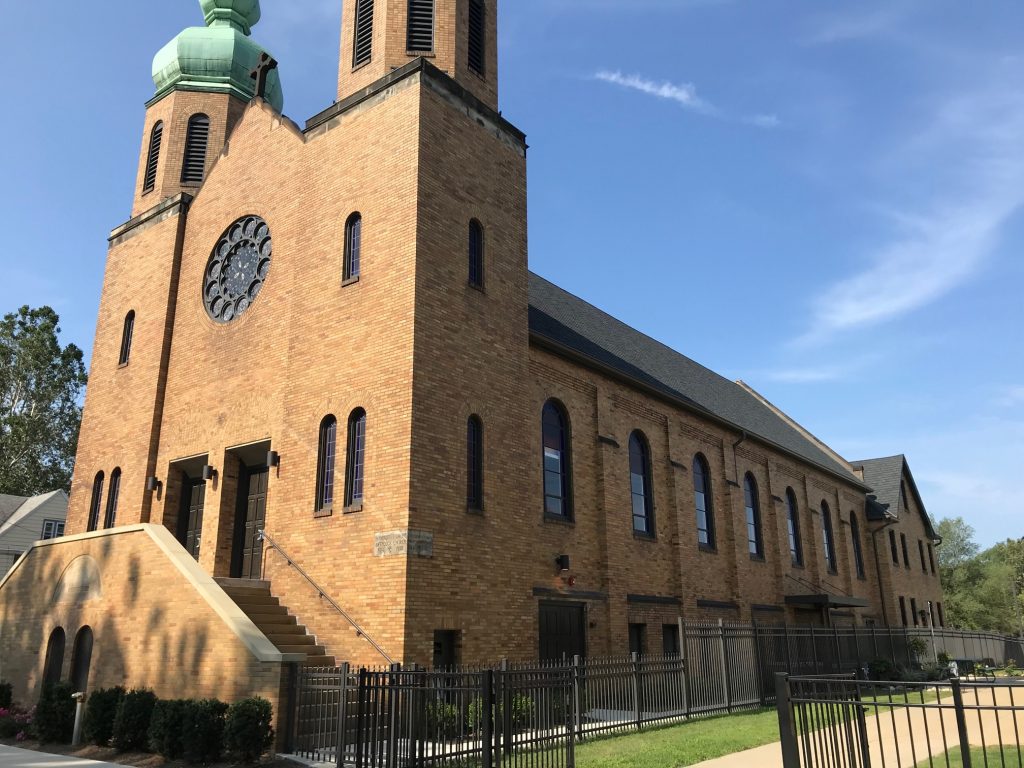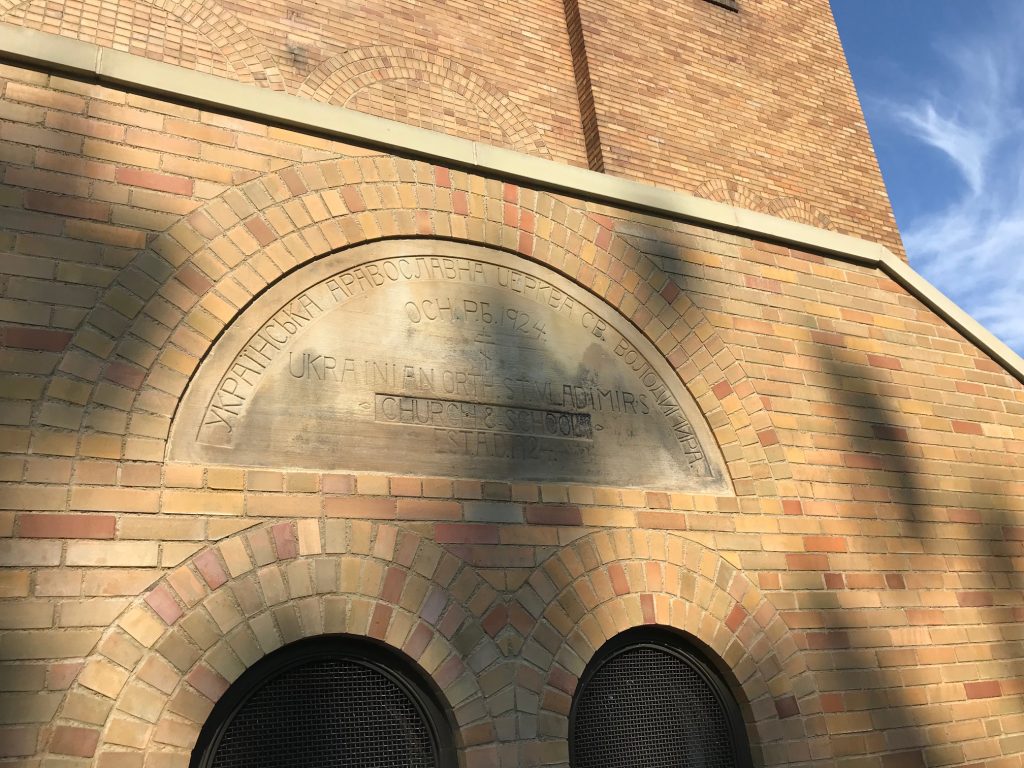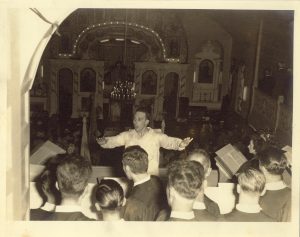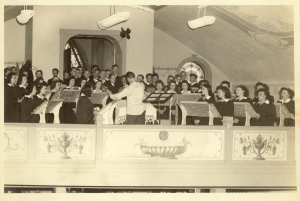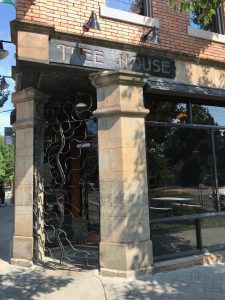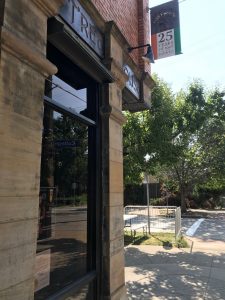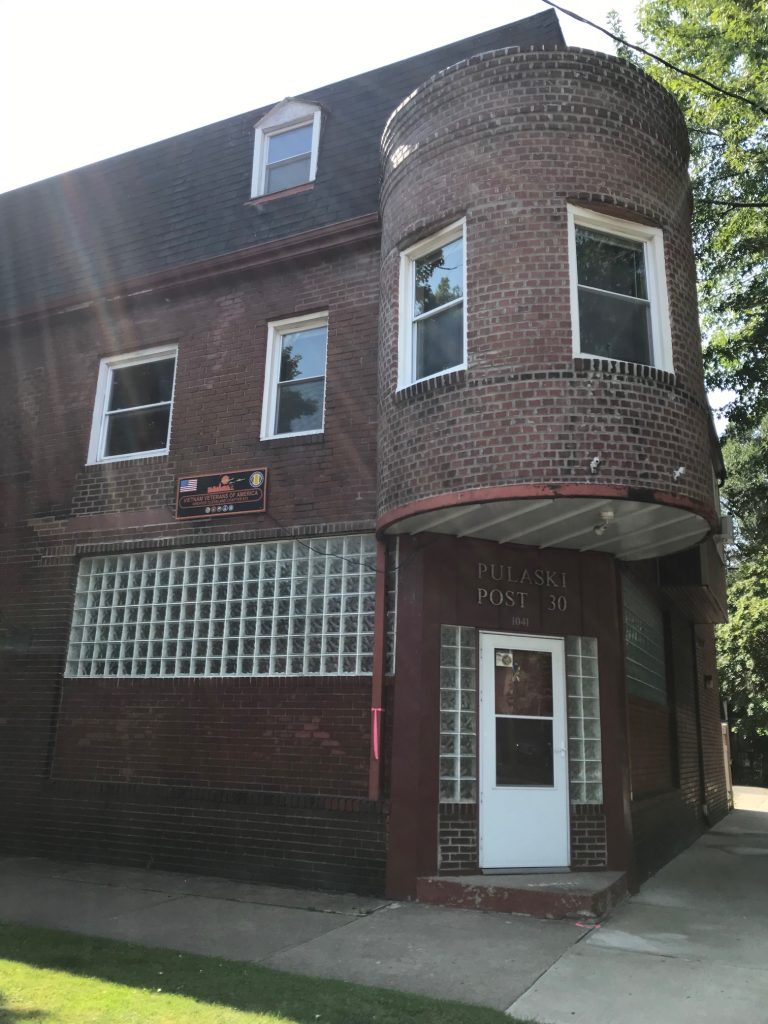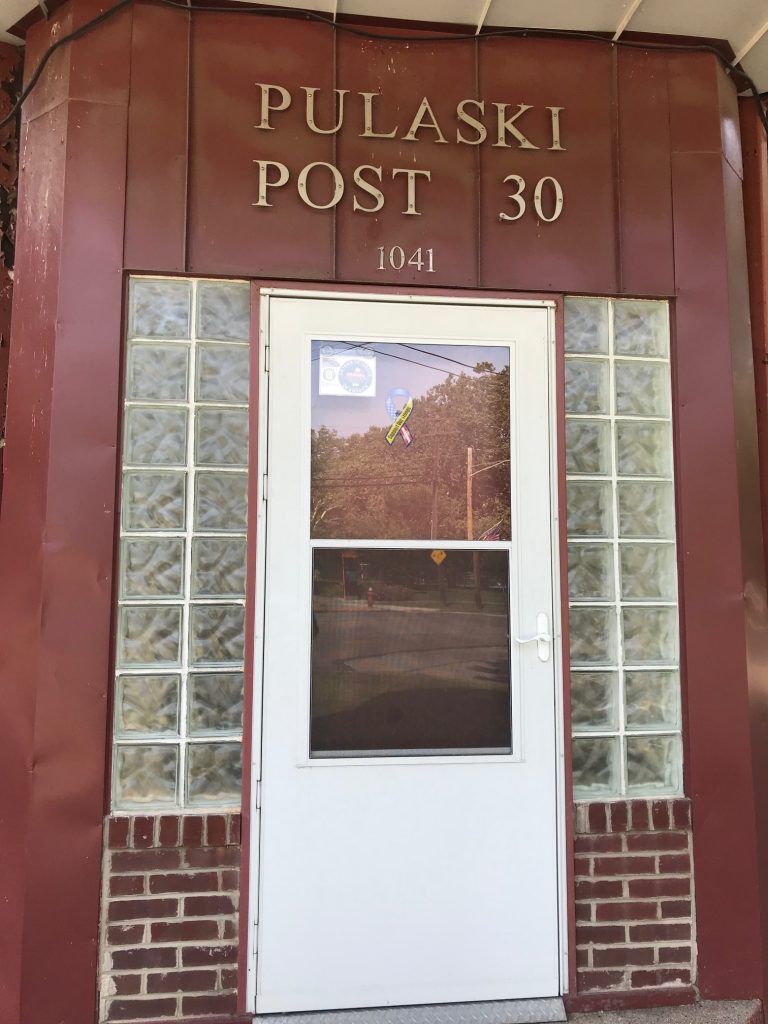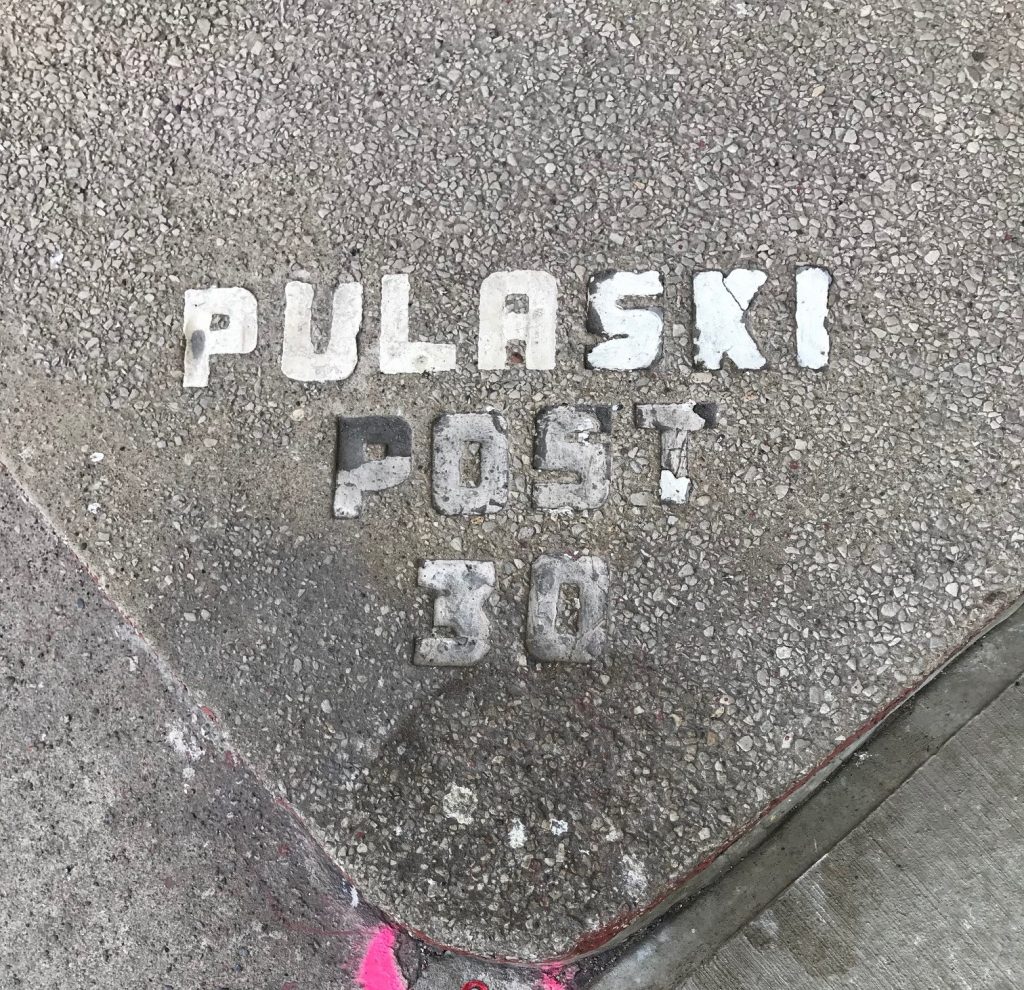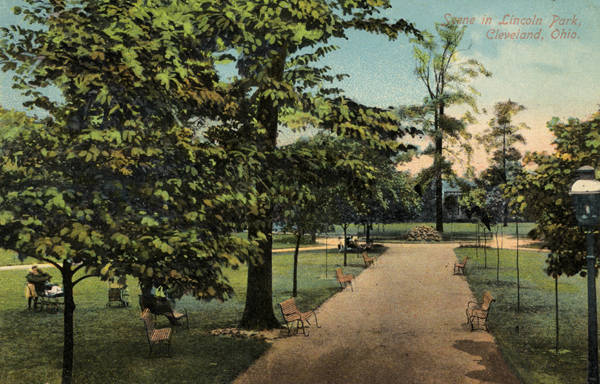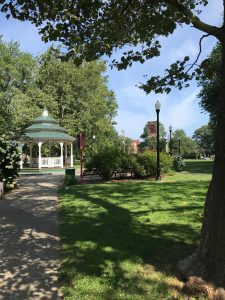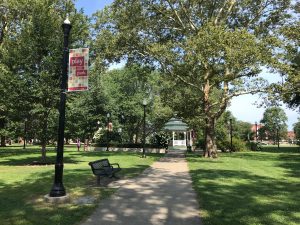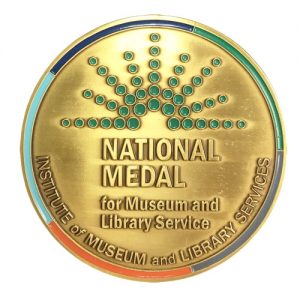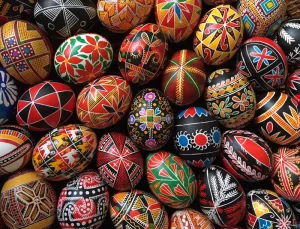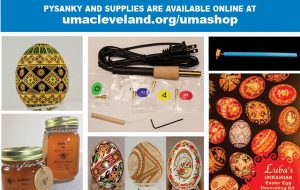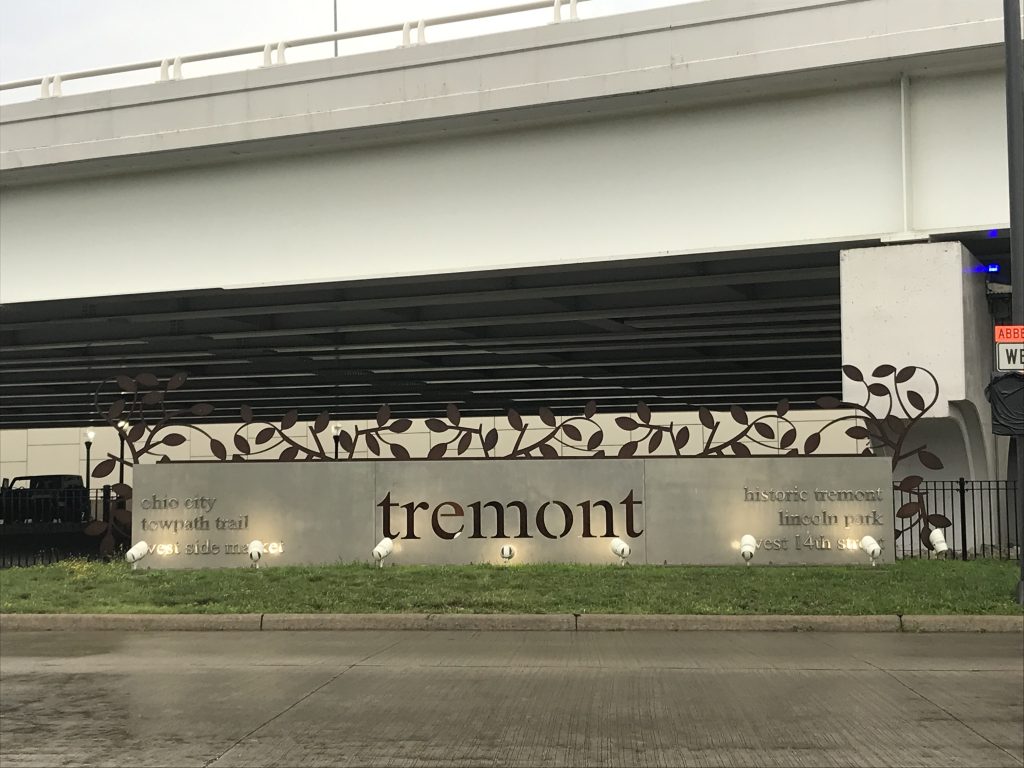
Welcome to a tour of locations in Tremont Ohio that hold a special place in the history of the Ukrainian immigrant community in Cleveland.
“The area known as Tremont… back in my mother’s time was called Lincoln Heights and as time went on…I’m guessing…somewhere in the 50s they called it the South Side. Why, I don’t know but if you lived in the area they’d call you a South Sider. And then later on when the renovations started you know with the area…that’s when they labeled it Tremont.” (Interview with Robert Ceccarelli, Tremont Oral History Project, 2003)

The Ukrainian community had several waves of immigration. Immigrants from the first wave in the 1900s and the second in the 1940s settled in the Tremont neighborhood.
“[i]t was like a small village… lived on Professor Street and that was parallel to West Fourteenth Street…business streets in Tremont. We had practically everything that was needed there was a butcher store, there was a grocery store, hardware store, doctor offices, funeral parlors, and many churches And it was very diversified neighborhood because it had a lot of different kinds of nationalities groups living there. And to this day they have many churches there. (Interview with Mollie Alstott, Tremont Oral History Project, 2003)
The community moved south, to Parma, and newer waves of immigrants to Cleveland settled in this suburb as well as in other suburbs on the east and south sides of the city. The points that are included in this tour are connected to the settlement in the 1900s and the displaced persons who fled World War II in the late 1940s and early 1950s.
The mission of the Ukrainian Museum Archives “to preserve and share Ukrainian culture and the immigrant experience,” is reflected in this walking tour that looks to the past 125 years of Ukrainian-American presence in Cleveland’s Tremont neighborhood.
Ukrainain Museum Archives
Between 1915 and1920, St. Peter & Paul Ukrainian Catholic Church owned this property and the property next door (1208 Kenilworth). The original parish school was located in the building on 1208 Kenilworth, which was later owned by Holowczak Funeral Home. The UMA purchased that property in 2011 and demolished the structurally unsound building to make room for the parking lot, keeping the garage building for UMA use.
This photo of a communion class from St. Peter and Paul church was taken in the back yard of the building where the UMA is located today. St. Peter and Paul Ukrainian Catholic Church had an orphanage here for children who lost their parents in the Great Influenza Epidemic of 1918-1919 or to industrial accidents or for other reasons. The building later because a residence for the nuns who taught at the school next door.
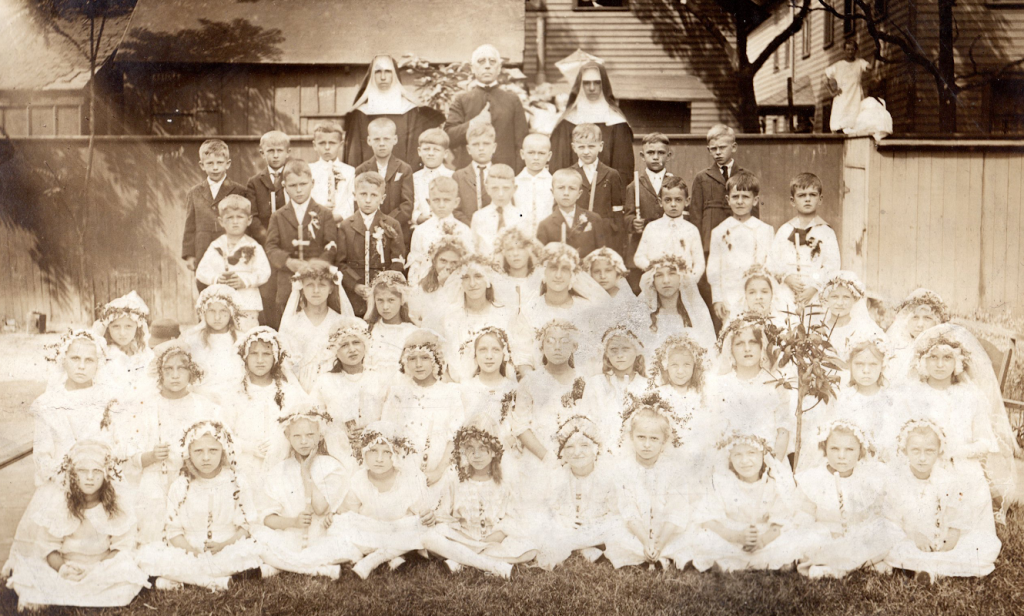
The Ukrainian Museum-Archives in Cleveland was founded in 1952 by displaced scholars who took on the mission of collecting and preserving items from Ukrainian history and culture during an era when this kind of material was being deliberately destroyed in Soviet Ukraine. Over the course of its first quarter-century, the UMA compiled a huge collection that includes many unique items.
In the 1950’s, this building was the original home of the Cleveland branch of Plast National Scout Organization of Ukraine (Пласт Національна Скаутська Організація України – Ukr.), frequently referred to simply as Plast, the largest Scouting organization in Ukraine.
At the building in Tremont, Mr. Bachynsky began a collection of books, magazines, and materials about Ukraine, Plast, and Ukrainian history and literature. His goal was to provide resources for Plast leaders as they developed activities and led meetings. The collection grew as parents and other supporters donated items to the collection.
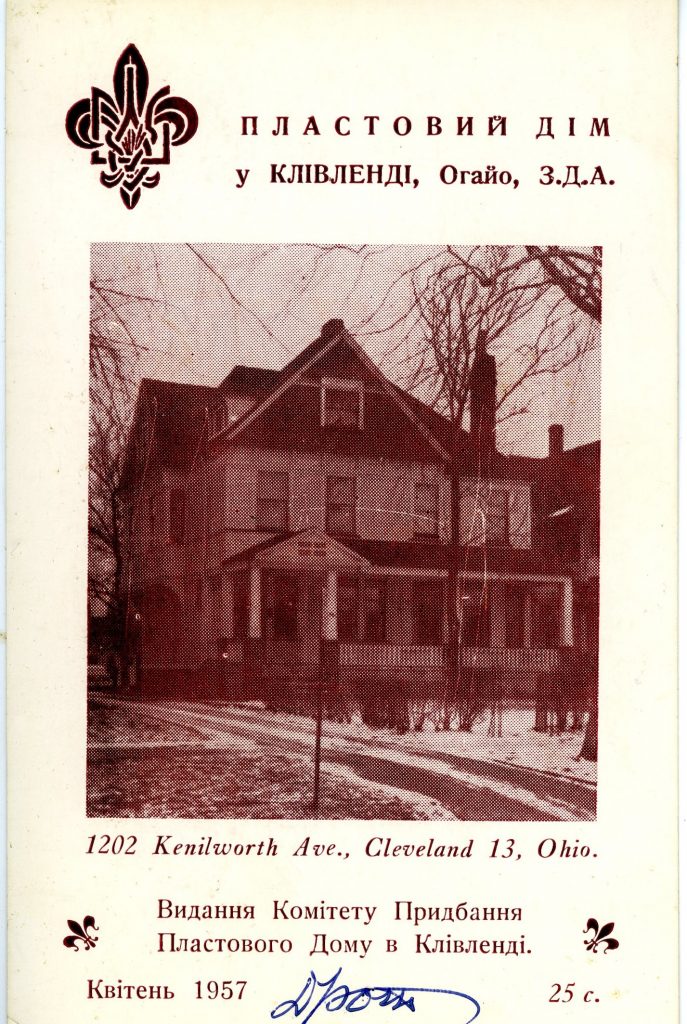
Postcard from 1957 with a photograph of the UMA building, which was at that time the home of Cleveland Plast, with the signature of Dr. Oleksander Tysovskyj (DROT), one of the founders of Plast. UMA Collection
During the 1960s, Ukrainian families began to move from the Tremont neighborhood to nearby Parma. When a new center was established for the Plast scouts, in Parma, the UMA bought the building and part of the Plast collection.
In the late 1970s, and throughout most of the ’80s, the UMA mirrored the neglect of the Tremont neighborhood. Starting in the early 1990s, the institution and the neighborhood began to experience renewal and growth.
A second generation of Ukrainian-Americans assumed responsibility for the UMA in the late 1980s and have continued to maintain and enhance the collection. We developed exhibits and hold regular events, both free-standing and in cooperation with the neighborhood. Much of the work is done by volunteers. Well-known events include the annual Easter Bazaar, Christmas party, and the summer Kupala Fest.
Ukrainian National Home
In 1870, industrialist Thomas Lamson built a home in Italianate style in what is now the Tremont neighborhood. Lamson was one of the founders of Lamson & Sessions, which in the late 1800 was a national leader in the production of nuts, bolts, and other fasteners. At that time, Jennings Avenue, later named West 14th Street, was lined with large beautiful homes of Cleveland area industrialists. The Olney building was designed by a firm that also designed homes on Euclid Avenue’s Millionaires’ Row and several buildings for Case Institute of Technology and Western Reserve University.
Lamson’s wife, Abbie Lamson Bradley, remodeled the home after she married Charles Olney and in 1894, the couple opened the Olney Art Gallery in one of the buildings. The gallery, which featured Olney’s expansive private art collection as well as art donated by other prominent Cleveland families was was open to the public and the space was also used for events and performances. Charles Olney died in 1903 and Abigail in 1904. The gallery closed in 1907, with the art collection bequeathed to Oberlin College.
The two structures were used briefly by the Polish National Church and in 1920, the two Olney structures – 2255 W. 14th Street and 2253 W. 14th Street – were purchased by the Ukrainian National Home Company. The Ukrainian community held social, educational, and recreational events in these spaces.
A former resident of Tremont recalled having lived in one of the homes, which the Ukrainian National Home acquired a decade later to provide a social and meeting space.
I was born in 1922, on the Southside. …I remember the address of the house I was born in. It was 2267 W14th Street…. it was a multifamily home. We had borders upstairs and a separate room in the back for my aunt and uncle. We didn’t charge them any rent back in those days. That’s how it was back in those times with large homes on W14th Street and they used them as multiple homes…Grace Hospital on one side and Ukrainian National Home on the other side…we had adjoining driveways. So, we had a sort of diamond in the backyard. We played ball back there and I remember breaking a few windows. [When the family moved] The Ukrainian National Home wanted to buy it. We sold it to them because they were such good neighbors. We had that common drive and they would take care of the drive and the backyard. (Interview with James and Angela Gantose, Tremont Oral History Project)
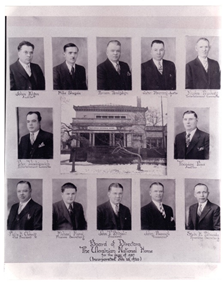
Board of Directors of the Ukrainian National Home 1937 (UMA Collection)
“I took dance lessons at the Ukrainian National Home….Lampson Session, Mr. Session used to own that. Well it used to be his home… [and] turned into the Ukrainian National Home afterwards. That was his art museum there that he built, because he had a lot of art. Paintings and stuff. So, he built the addition to that home of his. Then after that, the Ukrainians bought that. In fact, I found this. (Showing me a note). Isn’t that something? … It says please attend dancing practice to be held Friday January 26, 1934 at the Ukrainian National Home. J. Cahoot was the instructor. I don’t know why I kept this. (Interview with Olga Naugle, Tremont Oral History Project)
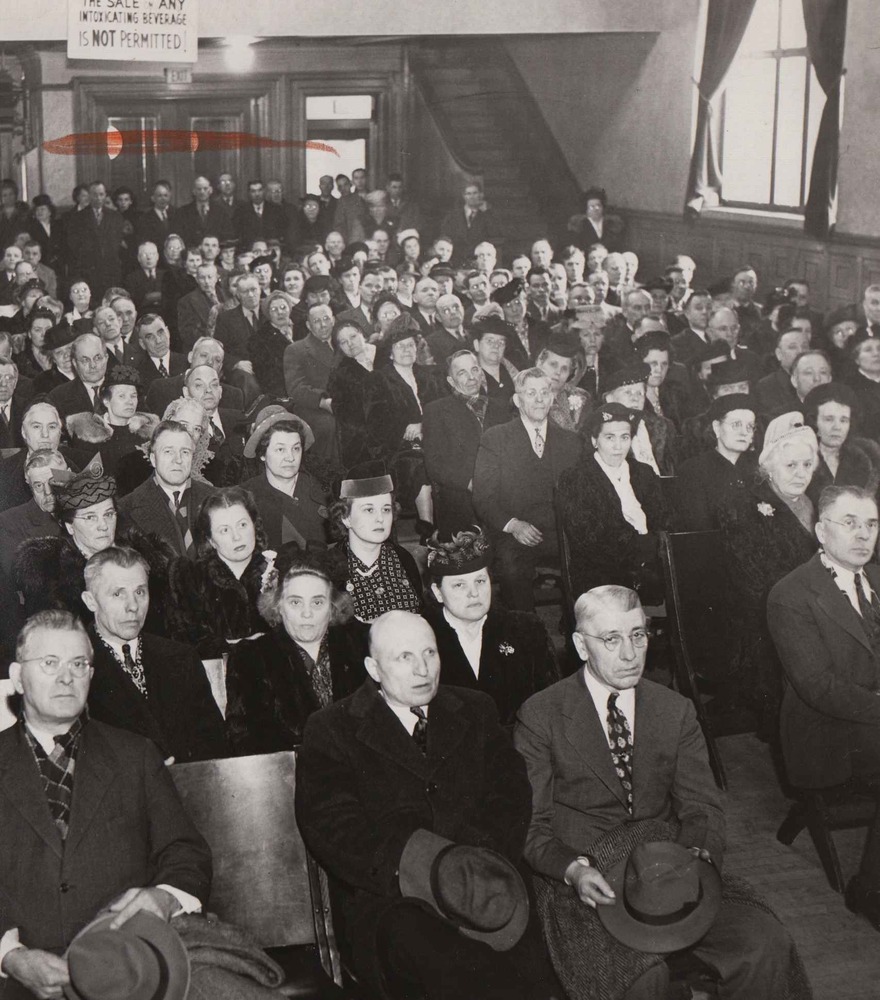
Members of the Cleveland Ukrainian community attend an event at the Ukrainian National Home in 1947.
ID: 7881 ~ Source: Cleveland Memory Project, Cleveland State University Library Special Collections ~ Date: 1947
“[T]he Ukrainian national home….was a fun time, because that’s where we held wedding receptions, that’s where we had plays, that’s where I had my piano debut (laughing). It was just a fun place to hang around, because if there was a dance or something, the kids would start in and eventually learn how to dance that way. There were a lot of good things that happened in that neighborhood to really prepare us for future days…. (Interview with Molllie Alstott, Tremont Oral History Project)
The Ukrainian National Home closed in 1967. A large portion of the Ukrainian community had moved to Parma, Ohio, and this town became the center of community life. The Ukrainian-American Youth Center occupied the space from 1967 through 1984.
The two Olney buildings later became a Puerto Rican social hall and since 1990, Grace Hospital has owned the two buildings. Currently, the restored Lamson Mansion and Olney Gallery, which are listed in the National Register of Historic Places are an event venue.
Saint Vladimir Orthodox church
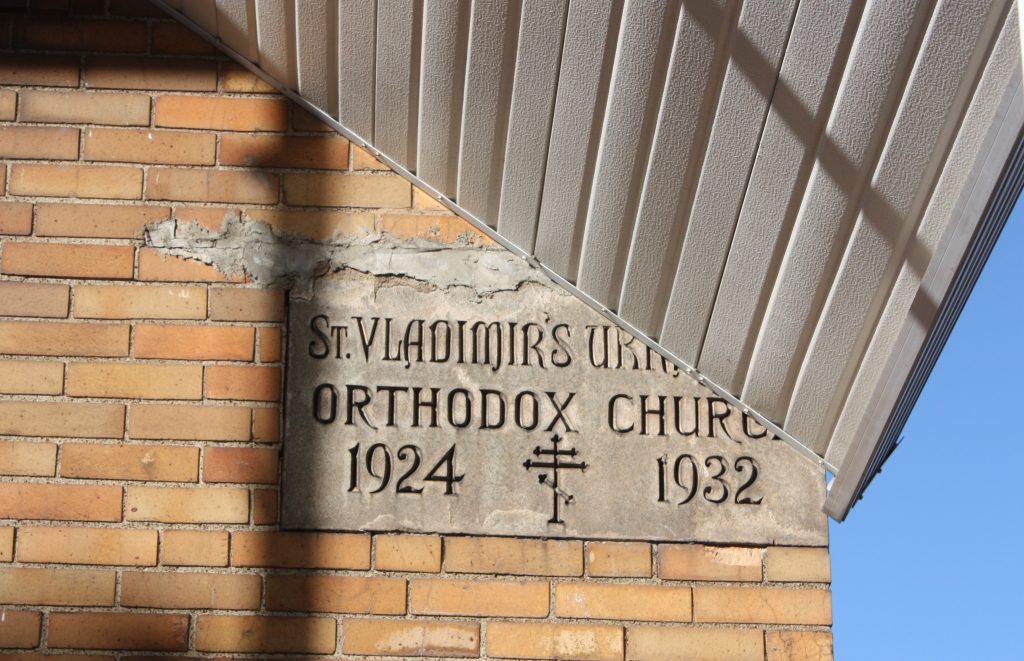
Saint Vladimir parish was founded in the year 1924, predominantly by pioneer immigrants from Western Ukraine. Construction for the church began around 1926, in the Tremont neighborhood and the church was dedicated in 1933. Many of the parish organizations were established during the early years of the parish.
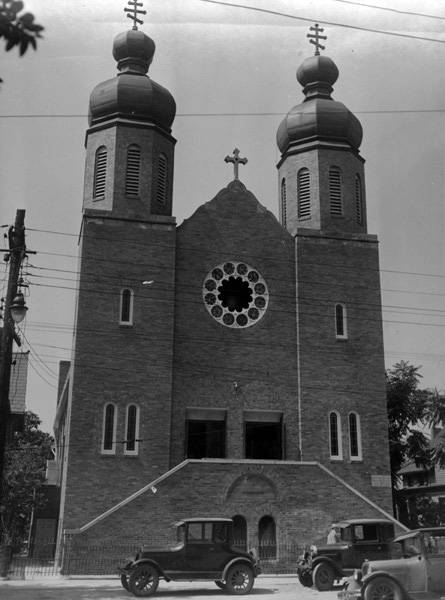
Saint Vladimir Ukrainian Orthodox Church, 1933
(Photograph Digital Archive Number CD 961 from the Cleveland State University Michael Schwartz Library. Special Collections, Donated by Joseph E. Cole.)
“[In the 1930s]…. It was fairly well mixed. There was the Greek Orthodox Church and the Ukrainian Orthodox Church, and St. George and the Russian (Orthodox Church), and we would have a parade around the neighborhood every Easter. We would have a parade with three or four churches. (Interview with James and Angela Gantose, Tremont Oral History Project)
After World War II, the parish was strengthened by more immigration from all regions of Ukraine. As the Ukrainian population shifted to the suburbs, the parish purchased property for a new church building in 1954. In 1967, the present church on State Road in Parma was consecrated for use.
[O]ne thing that you remember in the area is that there were a lot of Orthodox churches in the area. The processions that were held on Good Friday and at midnight on Easter. Annunciation, because it was close to St. Georges Syrian Orthodox also St. Vladimir’s Ukrainian Orthodox would have the parades. They would start out down 14th Street and come to St. Georges, stop there and continue on down Starkweather Avenue to West 11th, then go up to St. Vladimir’s and back to Annunciation and back to 14th and Fairfield. The church I went to was St. Theodosius, we were not that close to other Orthodox church so our precessions were just around the church and that. I remember those completely. (Interview with Vic Hanchuk , Tremont Oral History Project)
Most recently the property was occupied by the Spanish Assembly of God Church.
In 2019, Olympic Forest Products Company purchased the church building, an attached two-story rectory, a two-car garage and a parking lot. The company planned to reconfigure the church into open office space, conference and meeting rooms.
Fat Cats
This location has a long history of housing taverns and restaurants.
According to an oral history recording, in 1901 there was a tavern in this location that served been and also a homemade distillery.
“[My] grandfather owned a saloon…I really don’t know the name of it. Nobody bought it, and lost everything. … I guess it had been a tavern for many years. I think it only sold beer and wine. …[H]e bought it around 1901… And then unfortunately lost it about 25 years after that. And it was bought by one of the brewing companies. I think it was Wizey’s. …It was a social place, because the original bar, according to her cousin, who lived there, and her dad fell down the stairs and died there, said that was the original, the bar was in the same location as it was then….GH: I think what they did back then I mean the men used to come with their pails, and they’d get their beer. That, that type thing. … And then, my mother would, her story was that she would go down to the basement and make, I guess whiskey. (Interview With Elizabeth Hallal, Tremont Oral History Project, 2003)
[T]here was a bar it was owned [by] Ukrainians, the daughter was very good friends with my sister and it was a wine and beer place, but they, they sold whiskey- – Illegally. Now its called Fat Cats [laughing] (Interview With Elizabeth Hallal, Tremont Oral History Project, 2003)

In the 1960s , after the era of prohibition whiskey and selling beer in buckets was well over for many decades, the Melnyszyn family owned this building and ran Mark’s Café.
Marko Melniszyn, who along with his wife, Tania, owned Mark’s Cafe on West 10th Street in the Tremont neighborhood. Photo from family’s collection
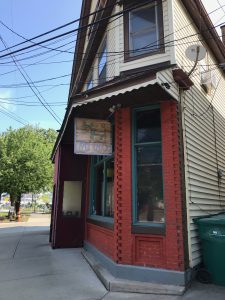
Fat Cats has been in this location for years, one of the first fine dining restaurants in the Tremont neighborhood.
Ukrainian Savings and Loan
Newly arrived immigrants to Cleveland, unable to receive loans from established banks, formed their own bank. The Ukrainian Savings Co, chartered in 1915 operated in the hall of Saints Peter and Paul Church for four years and then in several other locations in Tremont, including this space in the 1950s.
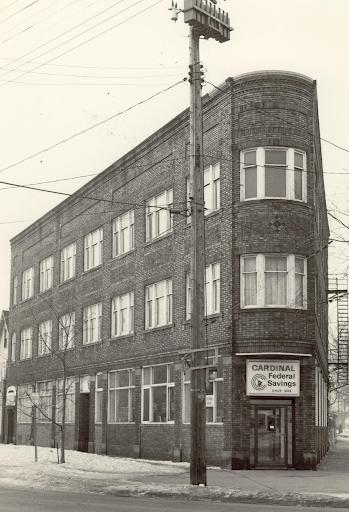
The bank moved to Parma in 1956 and was renamed The Parma Savings Company and later Cardinal Federal Savings Bank.
In the 1950s and 60s, this was the location of the Ukrainian Youth Association.
Saints Peter and Paul Ukrainian Catholic Church
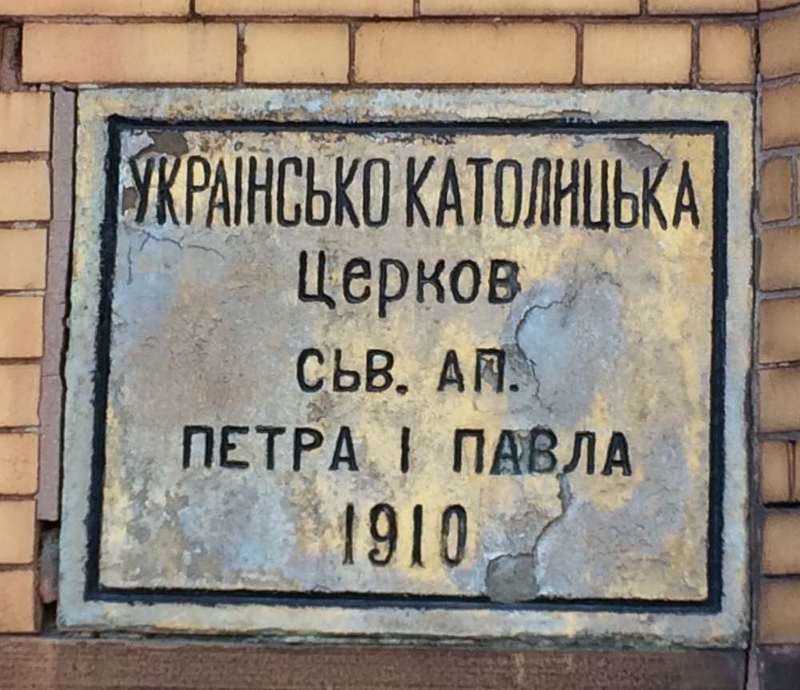
The cornerstone for Saints Peter and Paul Ukrainian Catholic Church was laid in 1910. The church had an active role in the community, supporting religious education as well as drama productions and Ukrainian language classes.
We had a [Ukrainian] school there [at] St. Peter and Paul’s. I went there to learn the language. (Olga Naugle, Tremont Oral History Project, 2003)
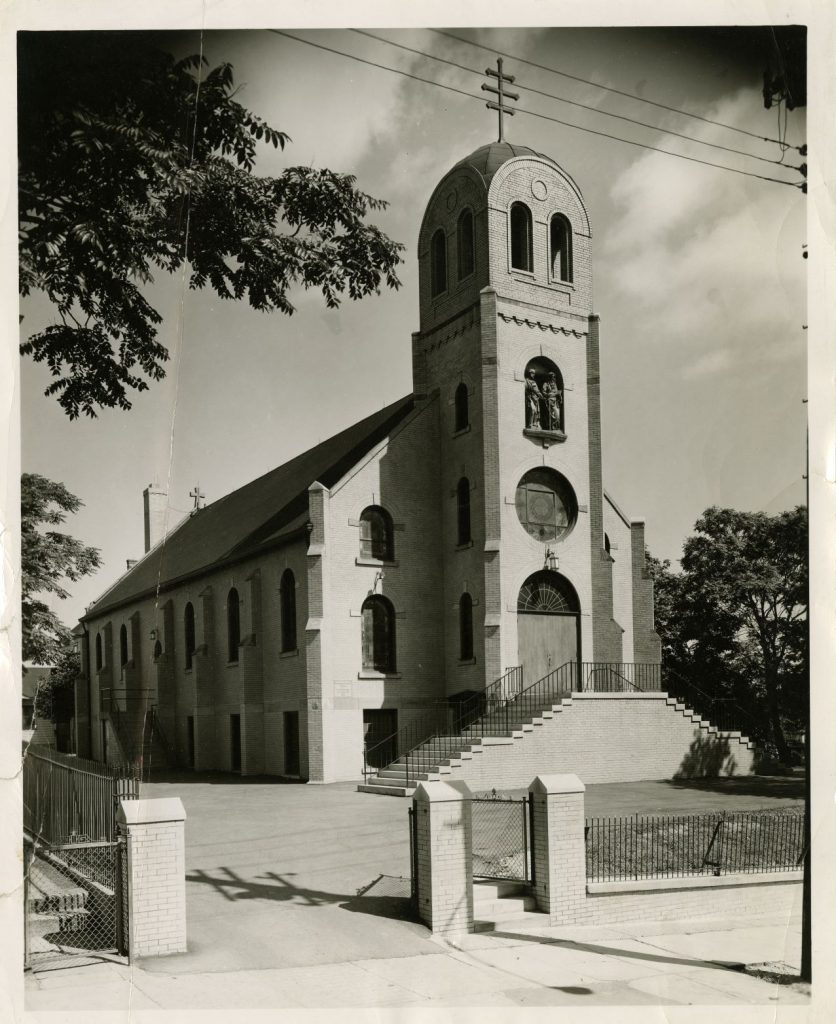
“And after going to Tremont elementary school most of the day, we came home and had a bite to eat and we went over to the church, because there we learned about Catechism and, bible church, Ukrainian language , and arts and culture too.” (Mollie Alstott, Tremont Oral History Project, 2003)
The church was renovated and redecorated In 1943, including the addition of a set of murals depicting scenes in the life of Christ. A convent was constructed in 1953 and the onion dome was replaced with a bell tower in 1956. Renovations in 1978 included new stained-glass windows.
“[T]he churches most of them churches have halls in them you know and they supplied the food and you have your polka bands and things like that. That’s the way most people in that area got married within the community. On a Saturday night you can probably find about five or six weddings going on in the neighborhood….[W]hen we were kids… we used to go to the back door to the halls and we used to knock on the back door to these old ethnic women making the food you know and we’d say, ‘We’re hungry can you feed us?’ you know and they’d say yeah sure and we’d get these plates of food and everything. Sit on a curb and chomp down on food. It was fun. (Robert Ceccaralli, Tremont Oral History Project, 2003)
Tree House
The location of the current Tree House was, in 1949, the F. Rybicki Grocery and Meat Market. The market was well-known in the neighborhood, and a source of groceries and food for Ukrainian immigrants.
“I don’t know if you heard of Treehouse down there. It’s like a bar. It’s pretty popular place. And uh it used to be an old meat market. You know my mother used to get her Easter kielbasa there. Now it’s a bar. A lot of little places like that they’re redoing.” (Interview with Robert Ceccaralli (Interview With Robert Ceccaralli, Tremont Oral History Project, 2003)
Edisons pub
This building has a long history in the community. In 1925, M Bochak Funeral Home was housed in this location.
The building became the property of the Barber family, who arrived in the United States in 1912.
“[Both my father and mother] came to this country really because of conditions in Europe and they knew that coming to America would give them a new life, and probably make more progress. A lot of their friends thought that they would come here and work for a while and then go back. So, a lot of them had that in mind, but as they lived here, they realized how well off they were. They also realized all of the opportunities that there were. (Interview with Mollie Alstott, Tremont Oral History Project)
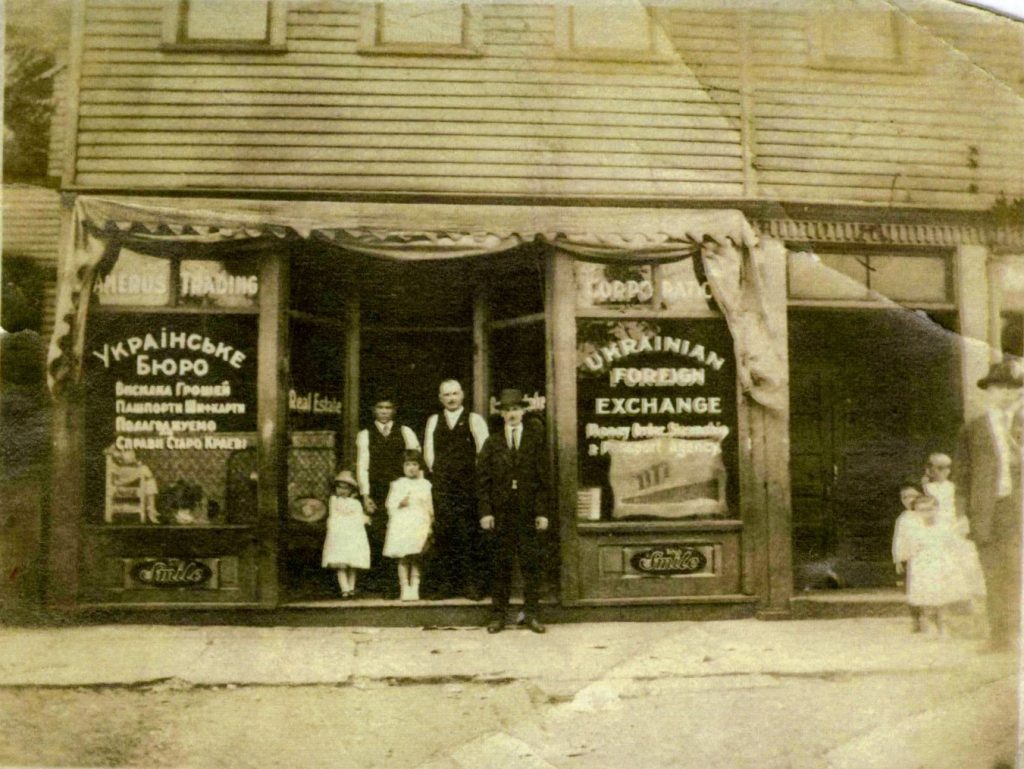
In the 1930s Andrew Barber ran Ukrainian Foreign Exchange and Andrew Barber Confectionery and Bakery in this location, allowing Ukrainian immigrants in the Tremont area a place to buy groceries and to maintain close ties with family in Ukraine.
My Dad had a confectionery store up front and we lived in quarters behind it… And hmm, upstairs, up front was a dentist office…. And then there were quarters for another family behind him. …the confectionery store had canned goods…lunch meat, cheeses, bagels, pickles things like that. Cleaning things. I remember the refrigerator, or the ice box we had there and then a candy area where they had a lot of goodies. I still have the little plates my Dad placed chocolate on….I remember we were always tempted with the candy of course, and lunch meat. (Interview with Mollie Alstott, Tremont Oral History Project)
After prohibition, the business changed to Barber Café. Andrew Barber’s daughter described:
“[L]ater on when prohibition was repealed, my father applied for a liquor license and then from then on he had a bar there. That I remember well, because at that time I was probably close to becoming a teenager….[There] were very few people that came from out of the neighborhood, there were people that worked in the steel mills for instance and would walk up and on their way up to catch the bus or streetcar maybe, they would have their favorite bars to stop in and they either stop in our bar or maybe the one on the corner that belonged to my uncle or maybe the one on the next block, because there was a number of bars, people drank in those days. (Interview with Irene Pavlyshyn, Tremont Oral History Project)
In 1989, Edison’s Pub, a popular bar, opened in this building on Professor Avenue
Merrick House
Merrick House Social Settlement was established in 1919 by the National Catholic War Council. The facility has been located on the same located on Starkweather Avenue and West 11th, on the northwest corner of Lincoln Park. Merrick House offered immigrants in the Tremont neighborhood English classes, child care, recreation, cultural programs, and clubs.
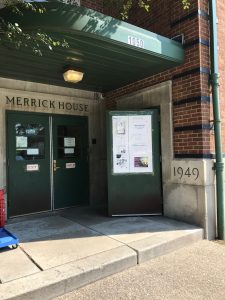
In this photograph, we see Irene Barber Pavlyshyn, (daughter of Andrew Barber and sister of Mollie Alstott, see Edison’s tour stop) leading an English language class at Merrick House. Mrs. Pavlyshyn and Mrs. Allstot were long-time community activists, supporting Ukrainian causes and the Ukrainian community.
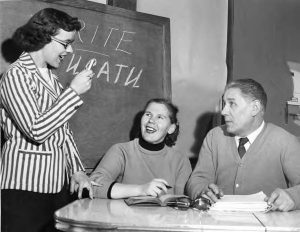
“Master of 2 languages (Ukrainian and Spanish) and now learning English are Mr & Mrs. Victor Lac. Instructor on left is Mrs. Irene Barber. They have been in this country 7 months after spending 10 yrs. in Argentina. They were born and married of Ukrainian parents in Poland
(Photograph Photo Number A6822, Digital Archive Number 1816 by Bob Tomsic, 1957, The Cleveland Press Collection, Michael Schwartz Library, Cleveland State University )
[T]he Merrick House, which is still there, was a very important thing for us because it offered social activities. We had clubs which we met there once a week and we had an advisor and it was just a very positive growing experience. They had art classes, which I attended…And they had dances and canteens. …like a sock hop kind of thing or something. …[I]t was open to everyone. …people could come in and learn English as a second language if they chose to. Learn their citizenship to prepare for their test. Then in the evenings they had the activities and on the weekends. And … there was a camp which is now in Hinckley and I don’t believe it’s a camp anymore. But they would provide the outdoor experience, too, for students in the community. (Interview with Dorothy Winovich, Tremont Oral History Project, 2003)
Merrick House, a vibrant neighborhood center, continues to educate individuals and families and serve the Tremont neighborhood and surrounding areas.
Pulaski Post 30 Polish Legion of American Veterans
In 1945, Harry R. (Whitey) Bigadza opened Whitey’s Lincoln Park Cafe on the south side of Cleveland across from Lincoln Park. He sold the business in 1949 and in 1953 opened Whitey’s Booze N’ Burgers in Richfield, Ohio.
“I don’t know whether you’ve ever gone to Booze and Burgers in Richfield—but my brother owns, he’s passed away but his son runs it now. It’s a big place, Whitey’s. [T]hey started in our neighborhood there. Right across the street from Merrick House, that one little corner there on Starkweather and West 11th. …They owned it and my brother started his business there. He was always in business. He had that haberdashery first, then he opened Whitey’s.” (Interview with Olga Naugle, Tremont Oral History Project, 2003)
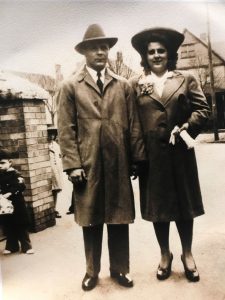
Harry (also know as Whitey) Bigadza with his
wife Magdalene (Maggie) Bigadza in front of their home on W. 11th Street in Tremont Ohio
The Polish Legion of American Veterans (PLAV) is an organization for honorably discharged U.S. and allied military veterans. At the conclusion of World War I, groups of American veterans of Polish descent formed organizations to maintain and preserve the spirit of fraternity and patriotism that arose from service in the Armed Forces of the United States and to provide mutual aid to veterans through patriotic, charitable, educational and civic activities. On July 23, 1984, President Ronald Regan signed an Act of Congress that granted a Federal Charter to the Polish Legion of American Veterans. The organization changed its membership rules in 1992 to no longer require Polish ancestry to join. The Post is used for meetings, to coordinate community service projects, and for social events. There are approximately 75 PLAVC posts, including Post 30 in the Tremont neighborhood.
Ukranian Labor Temple
Built in 1927, the Ukrainian Labor Temple on Auburn Avenue supported by the Soviet government was a center of activity for immigrants who identified with left-wing polictics and the USSR. That movement gradually died out in the 1970s and 1980s and the building was converted to an artist’s studio.
“Our primary togetherness was at a club called the Ukraine Labor Table Temple. It used to be on Auburn and West 11th Street. It was a social club for Ukrainians and they maintained a lot of the cultural heritage of the Ukraine there. They had Ukraine school that I attended to speak a little Ukrainian. They had concerts and they taught us Ukrainian dances and so on. They had a lot of picnics and a lot of banquets. Banquets and picnics all the time. The Picnics were south of Cleveland, generally south of Broadview land. When I was growing up the area was sparsely populated, there were farms. The farmers would rent out their land for picnics and so on. That was our major socialization.” (Interview with Eugene Bahniuk, Tremont Oral History Project, 2003)
“My [wedding] reception was in Tremont at the Ukrainian Labor Temple. It’s on the corner of West Tenth and Auburn. I believe it’s an artist’s studio now or something like that. …[M]ostly the people who belonged there were Russian. And it was like a social club. … I think, it had a lot to do with socialism and communism. I remember my father was investigated for that. Off the record. [Laughter] But they didn’t find anything about it. My father had more socialistic viewpoints on stuff. He was born in Russia so you have to realize that he had to get out of Russia when the revolution started. So he was more, sympathetic toward the revolutionaries. Because the country was so born and the aristocrats were so rich. I guess that was the time for a change. We didn’t share my father’s viewpoints. (Interview With Elizabeth Hallal, Tremont Oral History Project, 2003)
Lincoln Park Bathouse
At the turn of the 19th century, the city of Cleveland began constructing public bathhouses for Cleveland’s poorest residents who did not have bathtubs in their homes or who could not afford to heat bathwater.
“A lot of the people didn’t have facilities to take a bath in their house. In fact, we didn’t. We had a toilet, in a really cold room in the back of the house. But we had to take a bath in a galvanized tub once a week in the kitchen. So, it sounds funny I know, but the people in the neighborhood if they wanted to take a shower, they would take their soap and towel and go to the bathhouse and take a shower….[I]t was free. I never went and took a shower there. Because…I don’t know we never did. I believe my father might have gone there. …. The bathhouse was really nice. You know it was kept up nice, it was clean and everything.” (Interview with Elizabeth Hallal, Tremont Oral History Project)
The Lincoln Park Bathhouse designed to look like Roman baths with Doric columns and raised fish murals was opened in 1921. The bathhouse had separate stalls for men and women. As indoor plumbing became more readily available in the community, the bathhouse closed and in the 1930s became the Lincoln Park Recreation Center. Tremont residents remember using the area behind the bathhouse for recreation. The structure is now the Lincoln Park Condominiums.
[I]n early days when the settlers, I mean when the immigrants first came here, they used that bathhouse to shower in because often time the houses that they had, weren’t equipped with bathrooms, and they had outdoor bathrooms….This is like before the twenties. Of course, I was born in twenty-one, but this is what I hear and what I read about. …[W]when we were in high school, junior high, maybe, we used to go to the bathhouse to do our ice skating. They would freeze over that area behind it.(Interview with Mollie Alstott, Tremont Oral History Project)
Civilization
This building has a long history in the Tremont neighborhood. In 1916, it housed the F. Iatsevych I Spilka, a Ukrainian establishment.
Starting in the 1950s, West Town Printing Company was housed in this space.
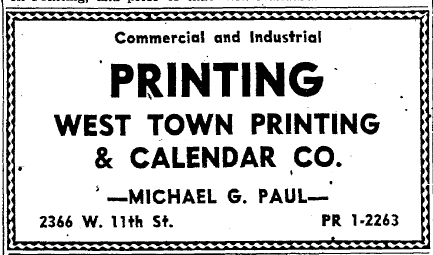
“It’s like the neighborhood print shop….you needed anything printed you know that’s where you went.…We used to pass out flyers for that guy…nail em, on poles…half the time we’d take…em and dump them down the sewer and told him we did it. … He paid us.” (Interview with Robert Ceccarelli, Tremont Oral History Project, 2003)
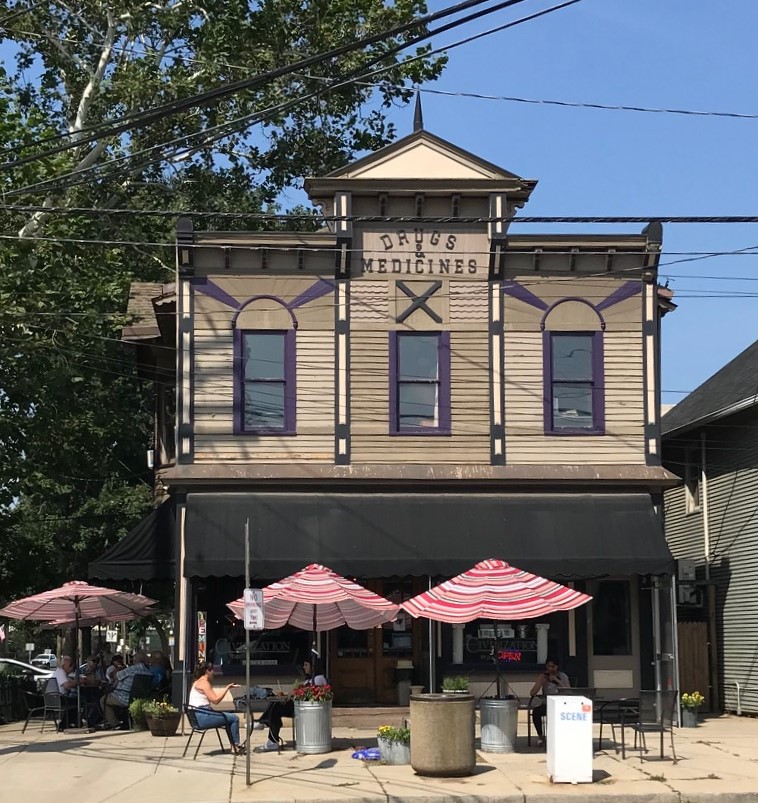
1990 – Civilizations, originally called Cravings, opened. The owners are active Tremont residents who work to improve the community. In 2014 a bike share station opened in front of the coffee shop.
Lemko Hall
From about 1909 or 1910, through the 1920s, this location housed “Koreny Hall,” a saloon, ballroom, and residence of immigrant Andrew Koreny and his family.
In the 1930s, The Lemko Association of Cleveland purchased Koreny Hall and renamed it Lemko Hall. Many immigrants to Cleveland traced their heritage to the Lemko region in the Beskid Mountains in Western Ukraine. A large number of Lemkos immigrated to Cleveland in the late 19th-century and settled in Tremont. By the early 1930s, Cleveland had the largest Lemko population of any city in the United States. Lemko’s kept their heritage alive in this building, which still bears the name, “Lemko.” The social club served as a community center for Lemkos. The community held concerts, lectures, weddings, language classes, and several of the Lemko Association’s national congresses in this building.
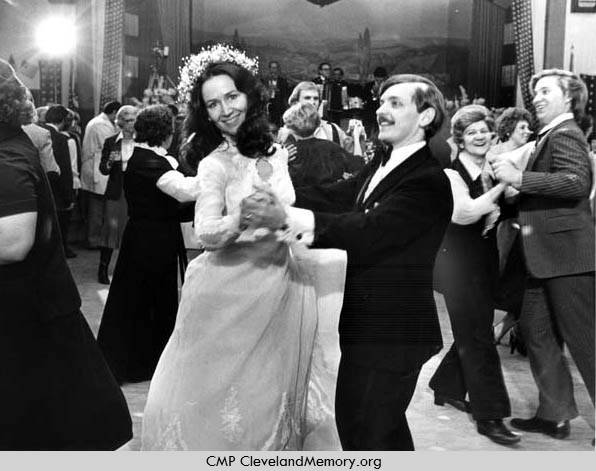
The Best Picture Academy Award winning film, The Deer Hunter was filmed in areas around Cleveland. Lemko Hall is widely known the location of the wedding scene in the movie.
Filming of Deer Hunter – Rutanya Alda (left) and Ken Kovacit dance at a wedding reception that took place at Lemko Hall. (Photograph by Bill Nehez, 1979, The Cleveland Press Collection, Michael Schwartz Library, Cleveland State University,
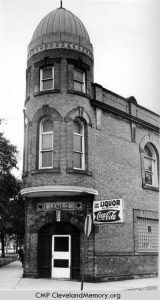
by Bernie Noble, 1973, The Cleveland Press Collection, Michael Schwartz Library, Cleveland State University)
In 1987, a developer bought Lemko Hall and converted the building into residential and commercial space. Lemko Hall was declared a landmark in 1988.
Lincoln Park
As you are looking at the UMA, behind you is Lincoln Park, a rectangular park located between W. 11th and W. 14th streets and Kenilworth and Starkweather avenues.
The land was known in the 1850s as “Pelton Park” after the family who owned it. Subsequently it was owned by the Pelton and Jennings firm, and was opened as a city park on July 4, 1880 after a seven years legal battle. By 1896, the park was restored with new walks, a fountain, and a bandstand, and eventually renamed Lincoln Park to commemorate President Lincoln’s brief encampment near this location with Union troops during the Civil War. In 1936, Lincoln Park was graded and landscaped under a WPA project and a swimming pool installed in the early 1950s.
(Postcards from the Postcards of Cleveland collection Photo number D 6557 and M 4890, at the Cleveland State University. Michael Schwartz Library. Special Collections, Donated by Walter Leedy. http://www.clevelandmemory.org/postcards/leedy.html.)
[In the 1920-1930s…there was a water trough for the horses, not on every corner but there was one in Lincoln Park.” (Interview with James and Angela Gantose, Tremont Oral History Project)
“When I was twelve years old my dad bought me a bike. I use to go bike riding [in Lincoln Park]; they used to have a lot of paths and everything. They had a large gazebo, a really large gazebo and they use to have band concerts there on Sunday. People in the neighborhood would come and enjoy themselves. And then they had little classes in dramatics, and ping pong, and stuff like that. Of course, there used to be a hedge all along the park that was like a spire hedge that was real large. So we use to play hide and seek there. In the center, they had a large pond, and they would fill it with water. In the summer the little kids would go in and splash around in there.” (Interview with Elizabeth Hallal, Tremont Oral History Project)
